ECTPP202A - Early Childhood Education and Care Program Design Report
VerifiedAdded on 2023/03/31
|12
|2274
|496
Report
AI Summary
This report provides a comprehensive overview of early childhood education and care, emphasizing the significance of program planning in fostering quality education and care for young children. It explores the cyclical nature of planning, highlighting the importance of play as a core element. The report delves into the impact of program planning on children's cognitive and developmental needs, referencing the National Quality Standard (NQS) and the Early Years Learning Framework (EYLF). It examines various educator philosophies, including those of Froebel and Bandura, and discusses the constructivist theoretical framework. The report further explores pedagogical approaches, the EYLF planning cycle, and includes a sample weekly program plan with activities. The conclusion reiterates the importance of frameworks like EYLF and NQS in guiding curriculum development and underscores the role of educators in understanding children's needs and developing activities accordingly. It also highlights the significance of reflection and evaluation in completing the programming cycle.
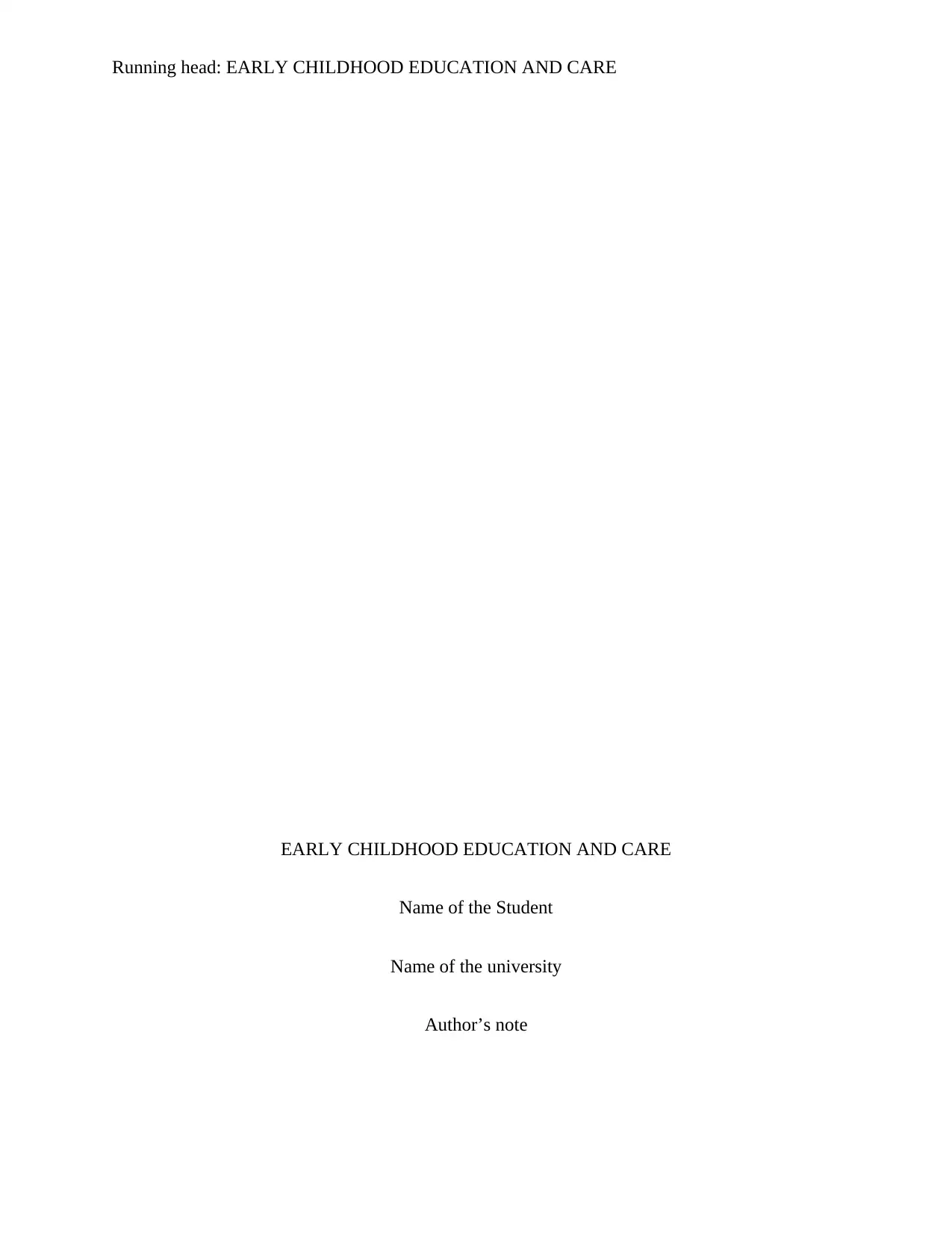
Running head: EARLY CHILDHOOD EDUCATION AND CARE
EARLY CHILDHOOD EDUCATION AND CARE
Name of the Student
Name of the university
Author’s note
EARLY CHILDHOOD EDUCATION AND CARE
Name of the Student
Name of the university
Author’s note
Paraphrase This Document
Need a fresh take? Get an instant paraphrase of this document with our AI Paraphraser
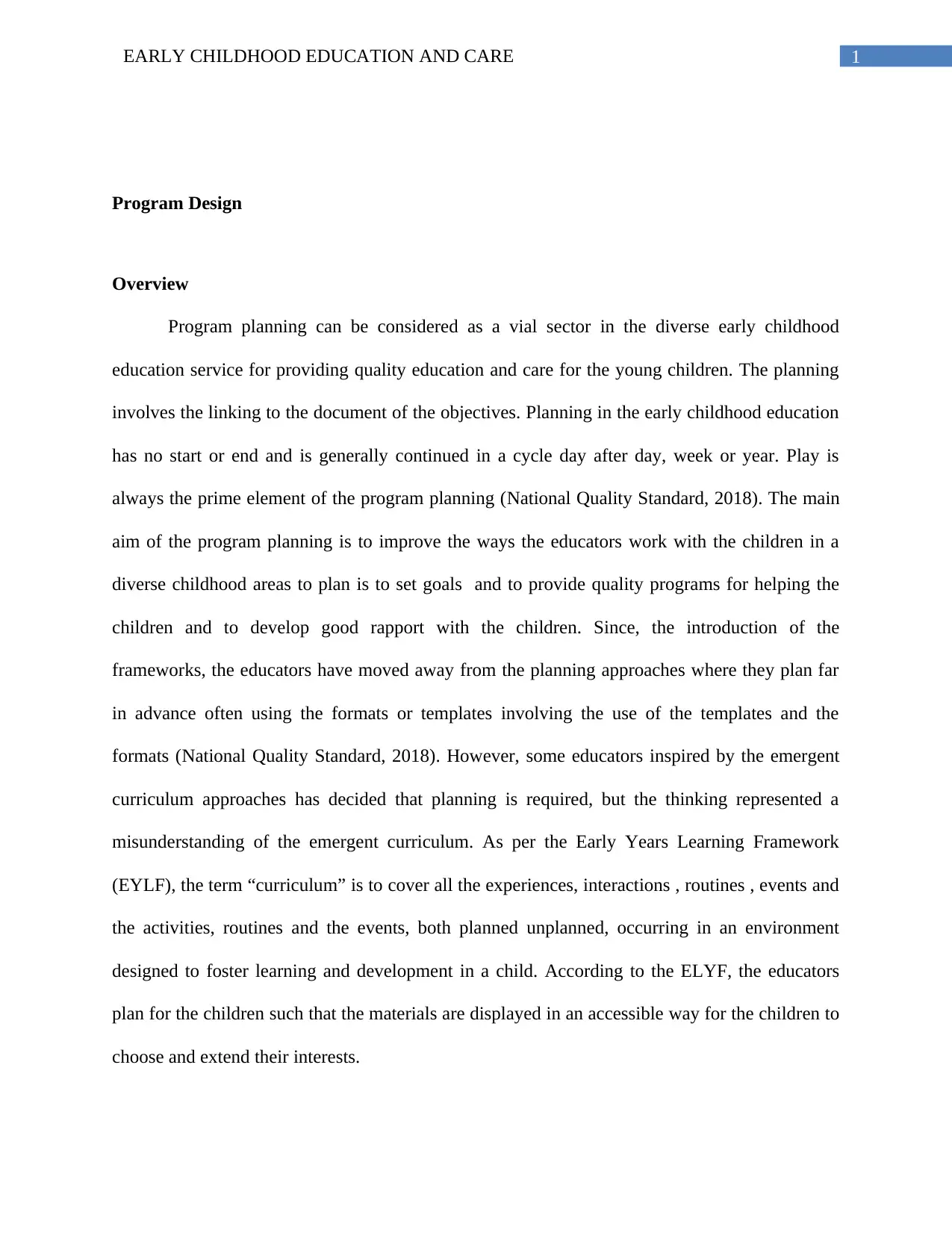
1EARLY CHILDHOOD EDUCATION AND CARE
Program Design
Overview
Program planning can be considered as a vial sector in the diverse early childhood
education service for providing quality education and care for the young children. The planning
involves the linking to the document of the objectives. Planning in the early childhood education
has no start or end and is generally continued in a cycle day after day, week or year. Play is
always the prime element of the program planning (National Quality Standard, 2018). The main
aim of the program planning is to improve the ways the educators work with the children in a
diverse childhood areas to plan is to set goals and to provide quality programs for helping the
children and to develop good rapport with the children. Since, the introduction of the
frameworks, the educators have moved away from the planning approaches where they plan far
in advance often using the formats or templates involving the use of the templates and the
formats (National Quality Standard, 2018). However, some educators inspired by the emergent
curriculum approaches has decided that planning is required, but the thinking represented a
misunderstanding of the emergent curriculum. As per the Early Years Learning Framework
(EYLF), the term “curriculum” is to cover all the experiences, interactions , routines , events and
the activities, routines and the events, both planned unplanned, occurring in an environment
designed to foster learning and development in a child. According to the ELYF, the educators
plan for the children such that the materials are displayed in an accessible way for the children to
choose and extend their interests.
Program Design
Overview
Program planning can be considered as a vial sector in the diverse early childhood
education service for providing quality education and care for the young children. The planning
involves the linking to the document of the objectives. Planning in the early childhood education
has no start or end and is generally continued in a cycle day after day, week or year. Play is
always the prime element of the program planning (National Quality Standard, 2018). The main
aim of the program planning is to improve the ways the educators work with the children in a
diverse childhood areas to plan is to set goals and to provide quality programs for helping the
children and to develop good rapport with the children. Since, the introduction of the
frameworks, the educators have moved away from the planning approaches where they plan far
in advance often using the formats or templates involving the use of the templates and the
formats (National Quality Standard, 2018). However, some educators inspired by the emergent
curriculum approaches has decided that planning is required, but the thinking represented a
misunderstanding of the emergent curriculum. As per the Early Years Learning Framework
(EYLF), the term “curriculum” is to cover all the experiences, interactions , routines , events and
the activities, routines and the events, both planned unplanned, occurring in an environment
designed to foster learning and development in a child. According to the ELYF, the educators
plan for the children such that the materials are displayed in an accessible way for the children to
choose and extend their interests.
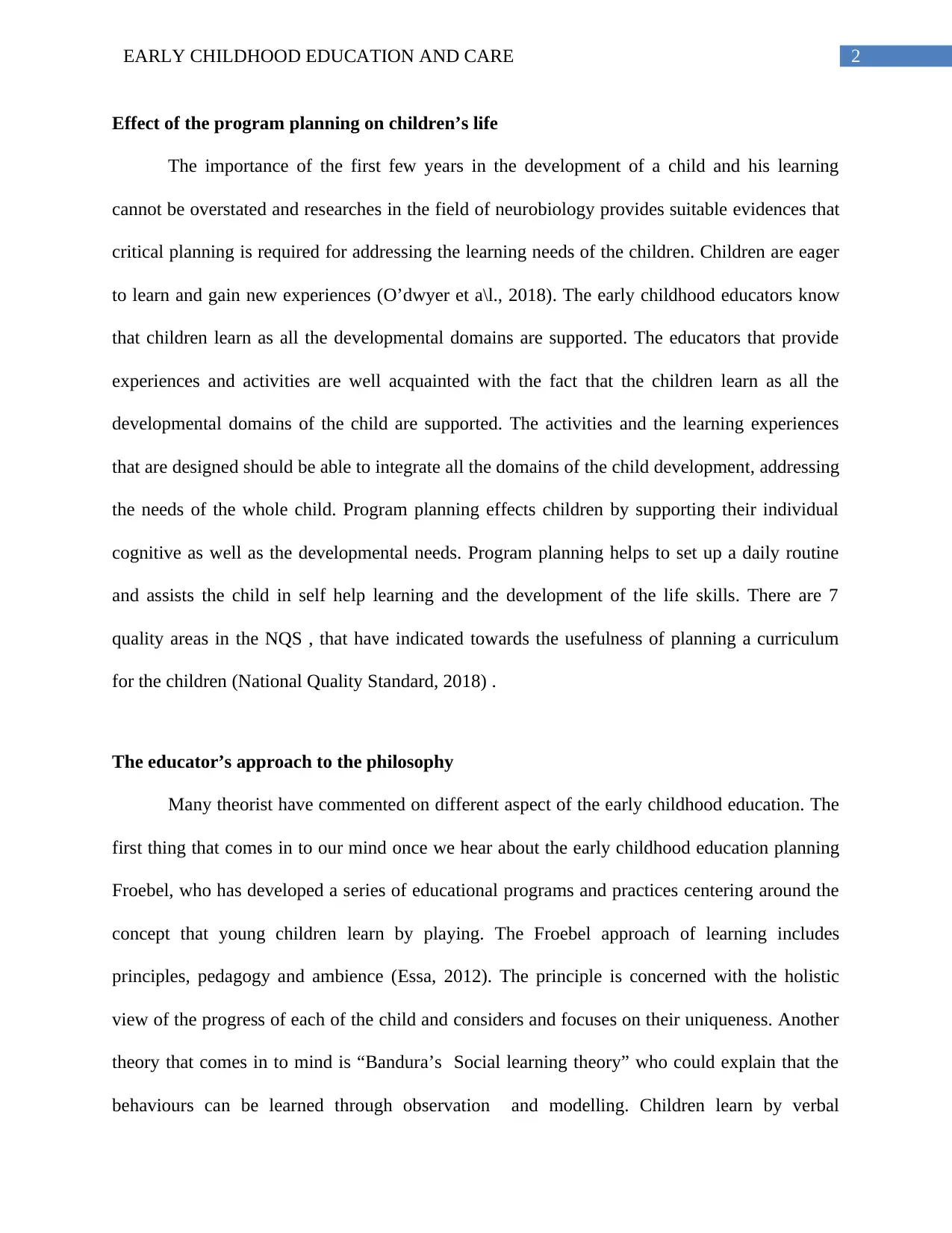
2EARLY CHILDHOOD EDUCATION AND CARE
Effect of the program planning on children’s life
The importance of the first few years in the development of a child and his learning
cannot be overstated and researches in the field of neurobiology provides suitable evidences that
critical planning is required for addressing the learning needs of the children. Children are eager
to learn and gain new experiences (O’dwyer et a\l., 2018). The early childhood educators know
that children learn as all the developmental domains are supported. The educators that provide
experiences and activities are well acquainted with the fact that the children learn as all the
developmental domains of the child are supported. The activities and the learning experiences
that are designed should be able to integrate all the domains of the child development, addressing
the needs of the whole child. Program planning effects children by supporting their individual
cognitive as well as the developmental needs. Program planning helps to set up a daily routine
and assists the child in self help learning and the development of the life skills. There are 7
quality areas in the NQS , that have indicated towards the usefulness of planning a curriculum
for the children (National Quality Standard, 2018) .
The educator’s approach to the philosophy
Many theorist have commented on different aspect of the early childhood education. The
first thing that comes in to our mind once we hear about the early childhood education planning
Froebel, who has developed a series of educational programs and practices centering around the
concept that young children learn by playing. The Froebel approach of learning includes
principles, pedagogy and ambience (Essa, 2012). The principle is concerned with the holistic
view of the progress of each of the child and considers and focuses on their uniqueness. Another
theory that comes in to mind is “Bandura’s Social learning theory” who could explain that the
behaviours can be learned through observation and modelling. Children learn by verbal
Effect of the program planning on children’s life
The importance of the first few years in the development of a child and his learning
cannot be overstated and researches in the field of neurobiology provides suitable evidences that
critical planning is required for addressing the learning needs of the children. Children are eager
to learn and gain new experiences (O’dwyer et a\l., 2018). The early childhood educators know
that children learn as all the developmental domains are supported. The educators that provide
experiences and activities are well acquainted with the fact that the children learn as all the
developmental domains of the child are supported. The activities and the learning experiences
that are designed should be able to integrate all the domains of the child development, addressing
the needs of the whole child. Program planning effects children by supporting their individual
cognitive as well as the developmental needs. Program planning helps to set up a daily routine
and assists the child in self help learning and the development of the life skills. There are 7
quality areas in the NQS , that have indicated towards the usefulness of planning a curriculum
for the children (National Quality Standard, 2018) .
The educator’s approach to the philosophy
Many theorist have commented on different aspect of the early childhood education. The
first thing that comes in to our mind once we hear about the early childhood education planning
Froebel, who has developed a series of educational programs and practices centering around the
concept that young children learn by playing. The Froebel approach of learning includes
principles, pedagogy and ambience (Essa, 2012). The principle is concerned with the holistic
view of the progress of each of the child and considers and focuses on their uniqueness. Another
theory that comes in to mind is “Bandura’s Social learning theory” who could explain that the
behaviours can be learned through observation and modelling. Children learn by verbal
⊘ This is a preview!⊘
Do you want full access?
Subscribe today to unlock all pages.

Trusted by 1+ million students worldwide
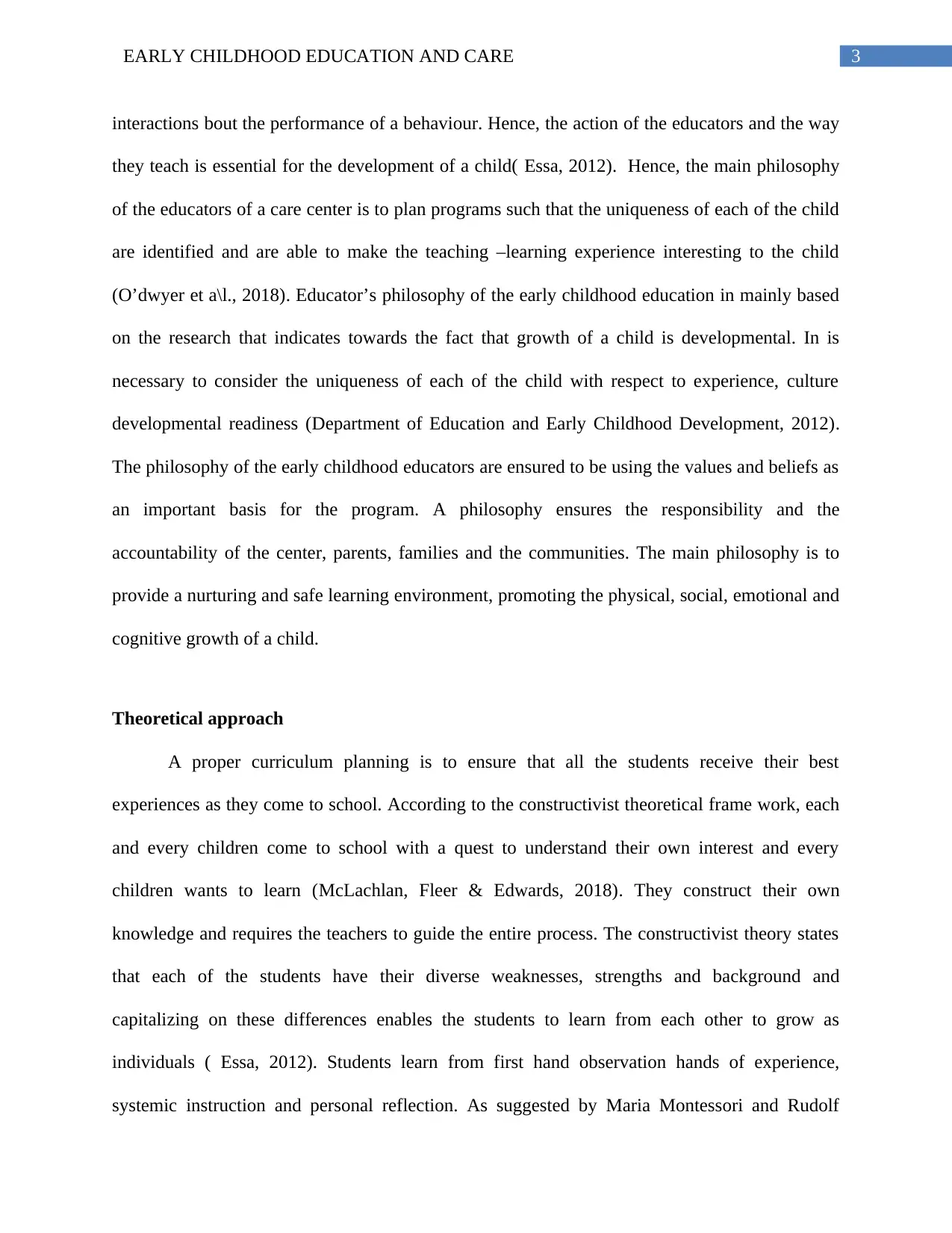
3EARLY CHILDHOOD EDUCATION AND CARE
interactions bout the performance of a behaviour. Hence, the action of the educators and the way
they teach is essential for the development of a child( Essa, 2012). Hence, the main philosophy
of the educators of a care center is to plan programs such that the uniqueness of each of the child
are identified and are able to make the teaching –learning experience interesting to the child
(O’dwyer et a\l., 2018). Educator’s philosophy of the early childhood education in mainly based
on the research that indicates towards the fact that growth of a child is developmental. In is
necessary to consider the uniqueness of each of the child with respect to experience, culture
developmental readiness (Department of Education and Early Childhood Development, 2012).
The philosophy of the early childhood educators are ensured to be using the values and beliefs as
an important basis for the program. A philosophy ensures the responsibility and the
accountability of the center, parents, families and the communities. The main philosophy is to
provide a nurturing and safe learning environment, promoting the physical, social, emotional and
cognitive growth of a child.
Theoretical approach
A proper curriculum planning is to ensure that all the students receive their best
experiences as they come to school. According to the constructivist theoretical frame work, each
and every children come to school with a quest to understand their own interest and every
children wants to learn (McLachlan, Fleer & Edwards, 2018). They construct their own
knowledge and requires the teachers to guide the entire process. The constructivist theory states
that each of the students have their diverse weaknesses, strengths and background and
capitalizing on these differences enables the students to learn from each other to grow as
individuals ( Essa, 2012). Students learn from first hand observation hands of experience,
systemic instruction and personal reflection. As suggested by Maria Montessori and Rudolf
interactions bout the performance of a behaviour. Hence, the action of the educators and the way
they teach is essential for the development of a child( Essa, 2012). Hence, the main philosophy
of the educators of a care center is to plan programs such that the uniqueness of each of the child
are identified and are able to make the teaching –learning experience interesting to the child
(O’dwyer et a\l., 2018). Educator’s philosophy of the early childhood education in mainly based
on the research that indicates towards the fact that growth of a child is developmental. In is
necessary to consider the uniqueness of each of the child with respect to experience, culture
developmental readiness (Department of Education and Early Childhood Development, 2012).
The philosophy of the early childhood educators are ensured to be using the values and beliefs as
an important basis for the program. A philosophy ensures the responsibility and the
accountability of the center, parents, families and the communities. The main philosophy is to
provide a nurturing and safe learning environment, promoting the physical, social, emotional and
cognitive growth of a child.
Theoretical approach
A proper curriculum planning is to ensure that all the students receive their best
experiences as they come to school. According to the constructivist theoretical frame work, each
and every children come to school with a quest to understand their own interest and every
children wants to learn (McLachlan, Fleer & Edwards, 2018). They construct their own
knowledge and requires the teachers to guide the entire process. The constructivist theory states
that each of the students have their diverse weaknesses, strengths and background and
capitalizing on these differences enables the students to learn from each other to grow as
individuals ( Essa, 2012). Students learn from first hand observation hands of experience,
systemic instruction and personal reflection. As suggested by Maria Montessori and Rudolf
Paraphrase This Document
Need a fresh take? Get an instant paraphrase of this document with our AI Paraphraser
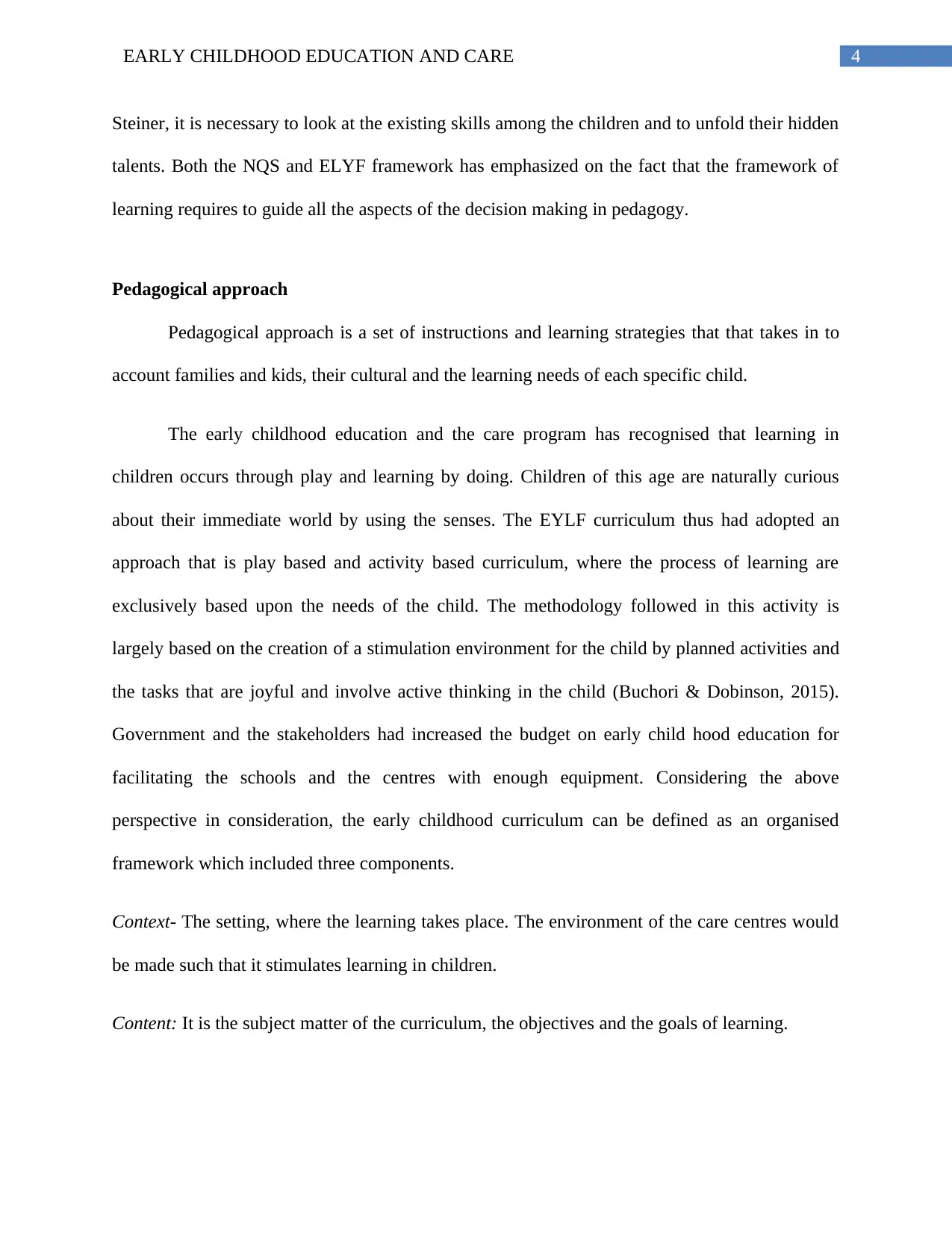
4EARLY CHILDHOOD EDUCATION AND CARE
Steiner, it is necessary to look at the existing skills among the children and to unfold their hidden
talents. Both the NQS and ELYF framework has emphasized on the fact that the framework of
learning requires to guide all the aspects of the decision making in pedagogy.
Pedagogical approach
Pedagogical approach is a set of instructions and learning strategies that that takes in to
account families and kids, their cultural and the learning needs of each specific child.
The early childhood education and the care program has recognised that learning in
children occurs through play and learning by doing. Children of this age are naturally curious
about their immediate world by using the senses. The EYLF curriculum thus had adopted an
approach that is play based and activity based curriculum, where the process of learning are
exclusively based upon the needs of the child. The methodology followed in this activity is
largely based on the creation of a stimulation environment for the child by planned activities and
the tasks that are joyful and involve active thinking in the child (Buchori & Dobinson, 2015).
Government and the stakeholders had increased the budget on early child hood education for
facilitating the schools and the centres with enough equipment. Considering the above
perspective in consideration, the early childhood curriculum can be defined as an organised
framework which included three components.
Context- The setting, where the learning takes place. The environment of the care centres would
be made such that it stimulates learning in children.
Content: It is the subject matter of the curriculum, the objectives and the goals of learning.
Steiner, it is necessary to look at the existing skills among the children and to unfold their hidden
talents. Both the NQS and ELYF framework has emphasized on the fact that the framework of
learning requires to guide all the aspects of the decision making in pedagogy.
Pedagogical approach
Pedagogical approach is a set of instructions and learning strategies that that takes in to
account families and kids, their cultural and the learning needs of each specific child.
The early childhood education and the care program has recognised that learning in
children occurs through play and learning by doing. Children of this age are naturally curious
about their immediate world by using the senses. The EYLF curriculum thus had adopted an
approach that is play based and activity based curriculum, where the process of learning are
exclusively based upon the needs of the child. The methodology followed in this activity is
largely based on the creation of a stimulation environment for the child by planned activities and
the tasks that are joyful and involve active thinking in the child (Buchori & Dobinson, 2015).
Government and the stakeholders had increased the budget on early child hood education for
facilitating the schools and the centres with enough equipment. Considering the above
perspective in consideration, the early childhood curriculum can be defined as an organised
framework which included three components.
Context- The setting, where the learning takes place. The environment of the care centres would
be made such that it stimulates learning in children.
Content: It is the subject matter of the curriculum, the objectives and the goals of learning.
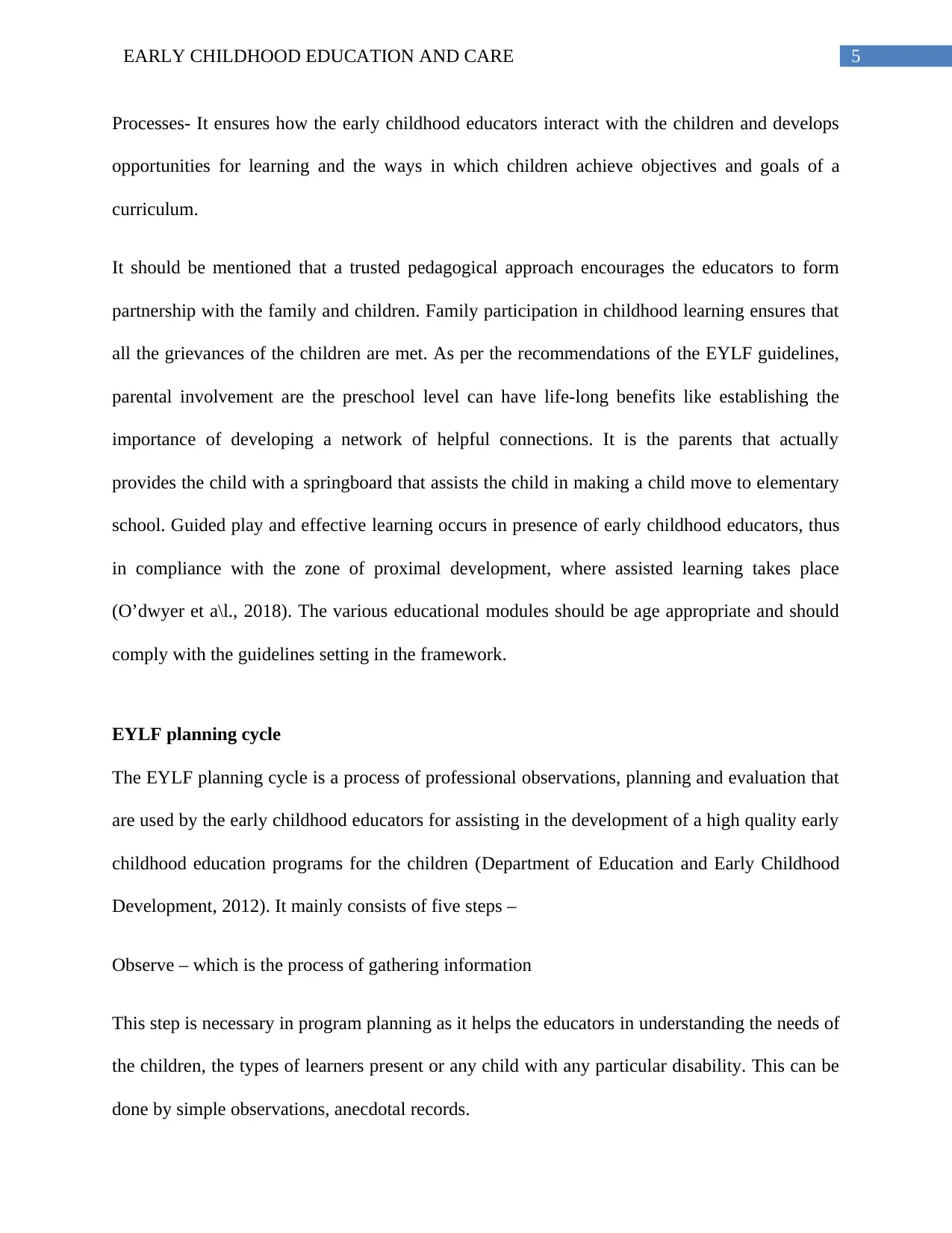
5EARLY CHILDHOOD EDUCATION AND CARE
Processes- It ensures how the early childhood educators interact with the children and develops
opportunities for learning and the ways in which children achieve objectives and goals of a
curriculum.
It should be mentioned that a trusted pedagogical approach encourages the educators to form
partnership with the family and children. Family participation in childhood learning ensures that
all the grievances of the children are met. As per the recommendations of the EYLF guidelines,
parental involvement are the preschool level can have life-long benefits like establishing the
importance of developing a network of helpful connections. It is the parents that actually
provides the child with a springboard that assists the child in making a child move to elementary
school. Guided play and effective learning occurs in presence of early childhood educators, thus
in compliance with the zone of proximal development, where assisted learning takes place
(O’dwyer et a\l., 2018). The various educational modules should be age appropriate and should
comply with the guidelines setting in the framework.
EYLF planning cycle
The EYLF planning cycle is a process of professional observations, planning and evaluation that
are used by the early childhood educators for assisting in the development of a high quality early
childhood education programs for the children (Department of Education and Early Childhood
Development, 2012). It mainly consists of five steps –
Observe – which is the process of gathering information
This step is necessary in program planning as it helps the educators in understanding the needs of
the children, the types of learners present or any child with any particular disability. This can be
done by simple observations, anecdotal records.
Processes- It ensures how the early childhood educators interact with the children and develops
opportunities for learning and the ways in which children achieve objectives and goals of a
curriculum.
It should be mentioned that a trusted pedagogical approach encourages the educators to form
partnership with the family and children. Family participation in childhood learning ensures that
all the grievances of the children are met. As per the recommendations of the EYLF guidelines,
parental involvement are the preschool level can have life-long benefits like establishing the
importance of developing a network of helpful connections. It is the parents that actually
provides the child with a springboard that assists the child in making a child move to elementary
school. Guided play and effective learning occurs in presence of early childhood educators, thus
in compliance with the zone of proximal development, where assisted learning takes place
(O’dwyer et a\l., 2018). The various educational modules should be age appropriate and should
comply with the guidelines setting in the framework.
EYLF planning cycle
The EYLF planning cycle is a process of professional observations, planning and evaluation that
are used by the early childhood educators for assisting in the development of a high quality early
childhood education programs for the children (Department of Education and Early Childhood
Development, 2012). It mainly consists of five steps –
Observe – which is the process of gathering information
This step is necessary in program planning as it helps the educators in understanding the needs of
the children, the types of learners present or any child with any particular disability. This can be
done by simple observations, anecdotal records.
⊘ This is a preview!⊘
Do you want full access?
Subscribe today to unlock all pages.

Trusted by 1+ million students worldwide
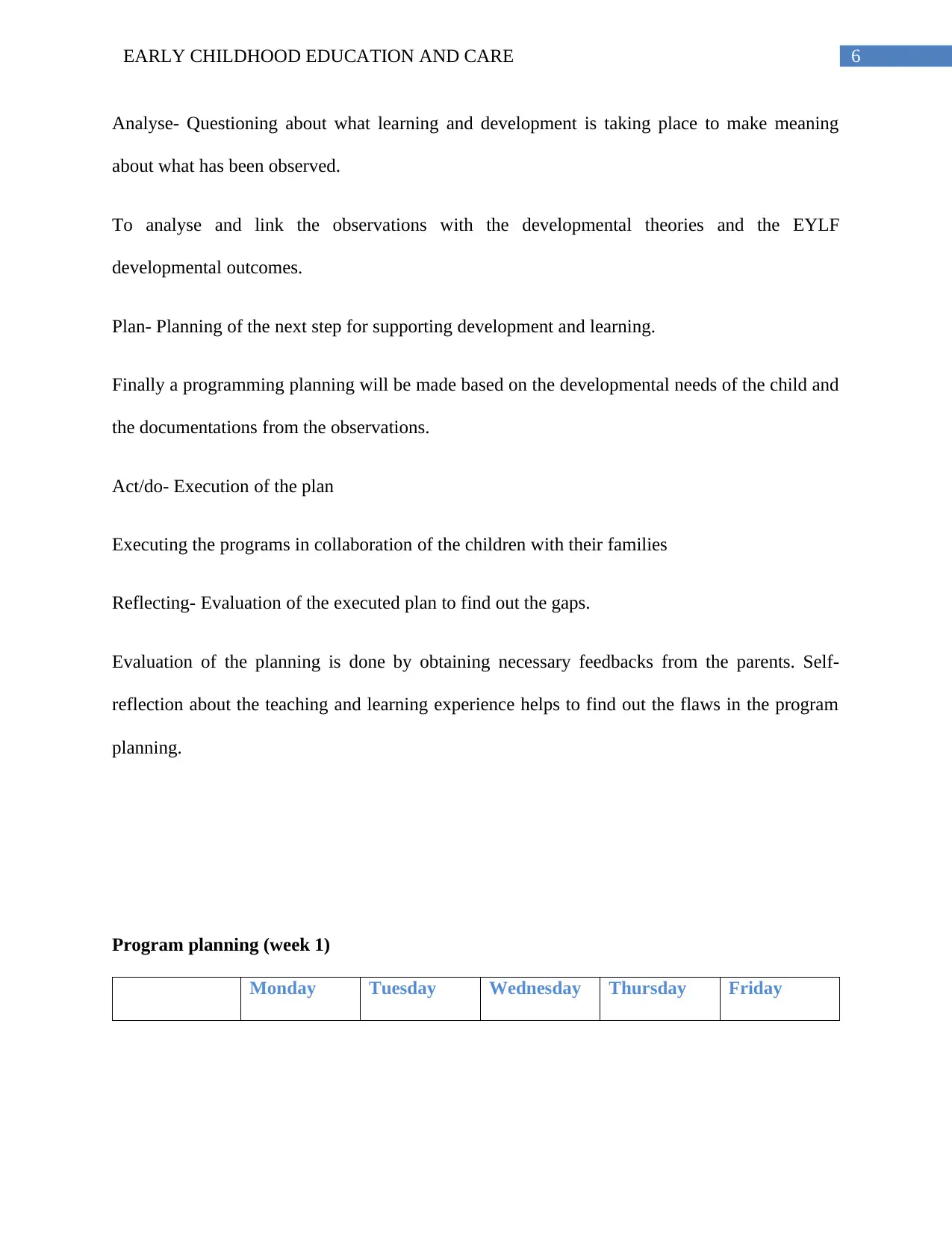
6EARLY CHILDHOOD EDUCATION AND CARE
Analyse- Questioning about what learning and development is taking place to make meaning
about what has been observed.
To analyse and link the observations with the developmental theories and the EYLF
developmental outcomes.
Plan- Planning of the next step for supporting development and learning.
Finally a programming planning will be made based on the developmental needs of the child and
the documentations from the observations.
Act/do- Execution of the plan
Executing the programs in collaboration of the children with their families
Reflecting- Evaluation of the executed plan to find out the gaps.
Evaluation of the planning is done by obtaining necessary feedbacks from the parents. Self-
reflection about the teaching and learning experience helps to find out the flaws in the program
planning.
Program planning (week 1)
Monday Tuesday Wednesday Thursday Friday
Analyse- Questioning about what learning and development is taking place to make meaning
about what has been observed.
To analyse and link the observations with the developmental theories and the EYLF
developmental outcomes.
Plan- Planning of the next step for supporting development and learning.
Finally a programming planning will be made based on the developmental needs of the child and
the documentations from the observations.
Act/do- Execution of the plan
Executing the programs in collaboration of the children with their families
Reflecting- Evaluation of the executed plan to find out the gaps.
Evaluation of the planning is done by obtaining necessary feedbacks from the parents. Self-
reflection about the teaching and learning experience helps to find out the flaws in the program
planning.
Program planning (week 1)
Monday Tuesday Wednesday Thursday Friday
Paraphrase This Document
Need a fresh take? Get an instant paraphrase of this document with our AI Paraphraser
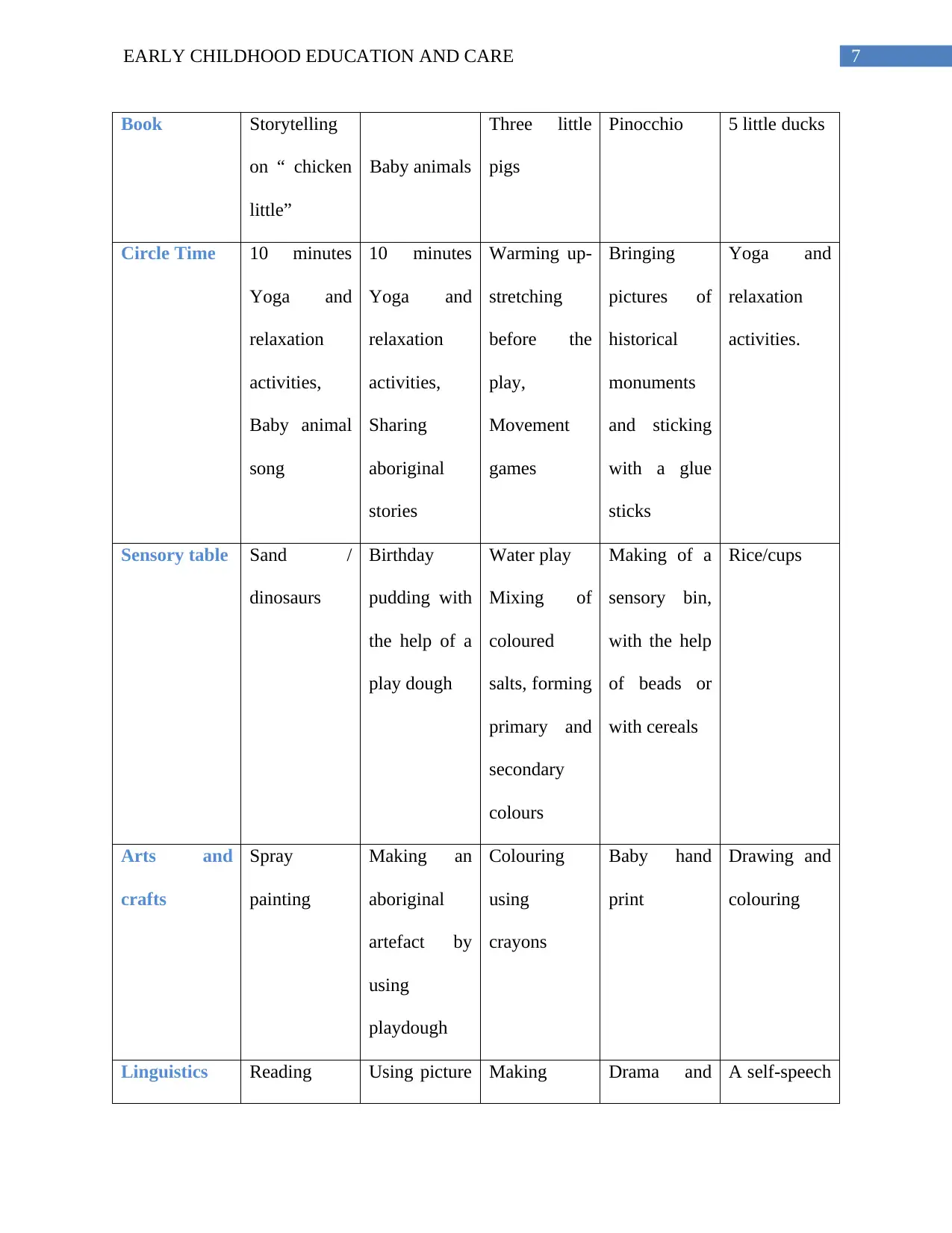
7EARLY CHILDHOOD EDUCATION AND CARE
Book Storytelling
on “ chicken
little”
Baby animals
Three little
pigs
Pinocchio 5 little ducks
Circle Time 10 minutes
Yoga and
relaxation
activities,
Baby animal
song
10 minutes
Yoga and
relaxation
activities,
Sharing
aboriginal
stories
Warming up-
stretching
before the
play,
Movement
games
Bringing
pictures of
historical
monuments
and sticking
with a glue
sticks
Yoga and
relaxation
activities.
Sensory table Sand /
dinosaurs
Birthday
pudding with
the help of a
play dough
Water play
Mixing of
coloured
salts, forming
primary and
secondary
colours
Making of a
sensory bin,
with the help
of beads or
with cereals
Rice/cups
Arts and
crafts
Spray
painting
Making an
aboriginal
artefact by
using
playdough
Colouring
using
crayons
Baby hand
print
Drawing and
colouring
Linguistics Reading Using picture Making Drama and A self-speech
Book Storytelling
on “ chicken
little”
Baby animals
Three little
pigs
Pinocchio 5 little ducks
Circle Time 10 minutes
Yoga and
relaxation
activities,
Baby animal
song
10 minutes
Yoga and
relaxation
activities,
Sharing
aboriginal
stories
Warming up-
stretching
before the
play,
Movement
games
Bringing
pictures of
historical
monuments
and sticking
with a glue
sticks
Yoga and
relaxation
activities.
Sensory table Sand /
dinosaurs
Birthday
pudding with
the help of a
play dough
Water play
Mixing of
coloured
salts, forming
primary and
secondary
colours
Making of a
sensory bin,
with the help
of beads or
with cereals
Rice/cups
Arts and
crafts
Spray
painting
Making an
aboriginal
artefact by
using
playdough
Colouring
using
crayons
Baby hand
Drawing and
colouring
Linguistics Reading Using picture Making Drama and A self-speech
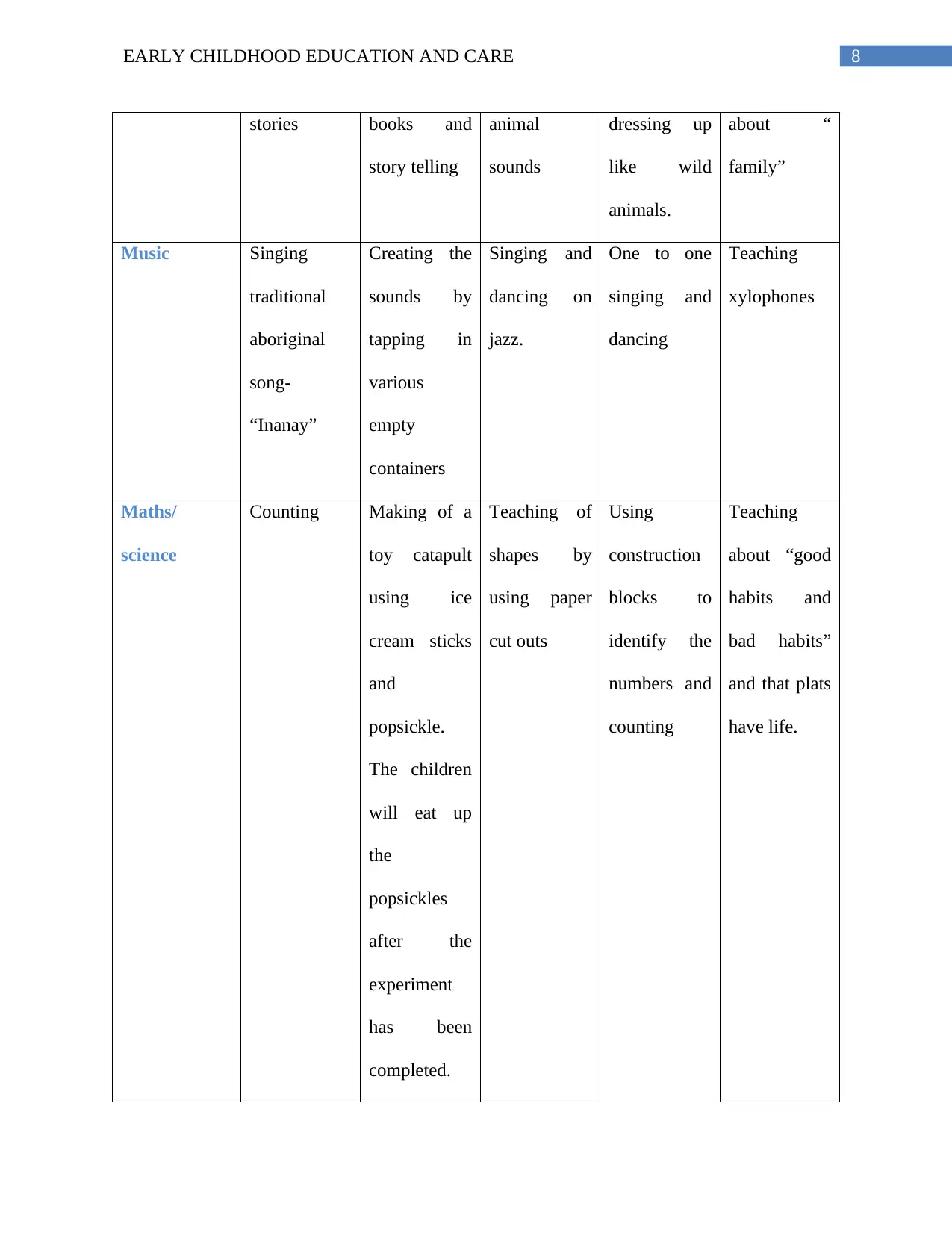
8EARLY CHILDHOOD EDUCATION AND CARE
stories books and
story telling
animal
sounds
dressing up
like wild
animals.
about “
family”
Music Singing
traditional
aboriginal
song-
“Inanay”
Creating the
sounds by
tapping in
various
empty
containers
Singing and
dancing on
jazz.
One to one
singing and
dancing
Teaching
xylophones
Maths/
science
Counting Making of a
toy catapult
using ice
cream sticks
and
popsickle.
The children
will eat up
the
popsickles
after the
experiment
has been
completed.
Teaching of
shapes by
using paper
cut outs
Using
construction
blocks to
identify the
numbers and
counting
Teaching
about “good
habits and
bad habits”
and that plats
have life.
stories books and
story telling
animal
sounds
dressing up
like wild
animals.
about “
family”
Music Singing
traditional
aboriginal
song-
“Inanay”
Creating the
sounds by
tapping in
various
empty
containers
Singing and
dancing on
jazz.
One to one
singing and
dancing
Teaching
xylophones
Maths/
science
Counting Making of a
toy catapult
using ice
cream sticks
and
popsickle.
The children
will eat up
the
popsickles
after the
experiment
has been
completed.
Teaching of
shapes by
using paper
cut outs
Using
construction
blocks to
identify the
numbers and
counting
Teaching
about “good
habits and
bad habits”
and that plats
have life.
⊘ This is a preview!⊘
Do you want full access?
Subscribe today to unlock all pages.

Trusted by 1+ million students worldwide
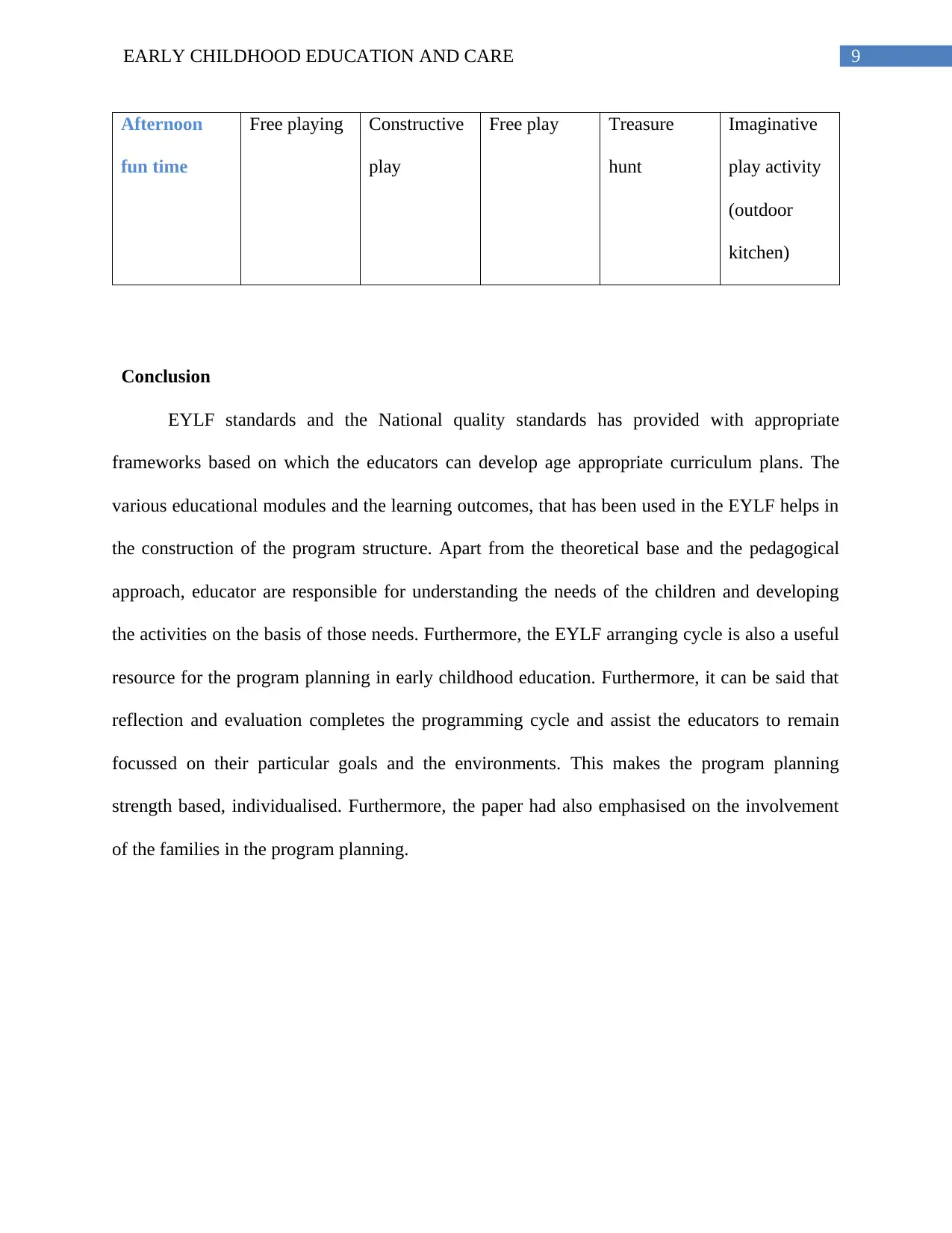
9EARLY CHILDHOOD EDUCATION AND CARE
Afternoon
fun time
Free playing Constructive
play
Free play Treasure
hunt
Imaginative
play activity
(outdoor
kitchen)
Conclusion
EYLF standards and the National quality standards has provided with appropriate
frameworks based on which the educators can develop age appropriate curriculum plans. The
various educational modules and the learning outcomes, that has been used in the EYLF helps in
the construction of the program structure. Apart from the theoretical base and the pedagogical
approach, educator are responsible for understanding the needs of the children and developing
the activities on the basis of those needs. Furthermore, the EYLF arranging cycle is also a useful
resource for the program planning in early childhood education. Furthermore, it can be said that
reflection and evaluation completes the programming cycle and assist the educators to remain
focussed on their particular goals and the environments. This makes the program planning
strength based, individualised. Furthermore, the paper had also emphasised on the involvement
of the families in the program planning.
Afternoon
fun time
Free playing Constructive
play
Free play Treasure
hunt
Imaginative
play activity
(outdoor
kitchen)
Conclusion
EYLF standards and the National quality standards has provided with appropriate
frameworks based on which the educators can develop age appropriate curriculum plans. The
various educational modules and the learning outcomes, that has been used in the EYLF helps in
the construction of the program structure. Apart from the theoretical base and the pedagogical
approach, educator are responsible for understanding the needs of the children and developing
the activities on the basis of those needs. Furthermore, the EYLF arranging cycle is also a useful
resource for the program planning in early childhood education. Furthermore, it can be said that
reflection and evaluation completes the programming cycle and assist the educators to remain
focussed on their particular goals and the environments. This makes the program planning
strength based, individualised. Furthermore, the paper had also emphasised on the involvement
of the families in the program planning.
Paraphrase This Document
Need a fresh take? Get an instant paraphrase of this document with our AI Paraphraser
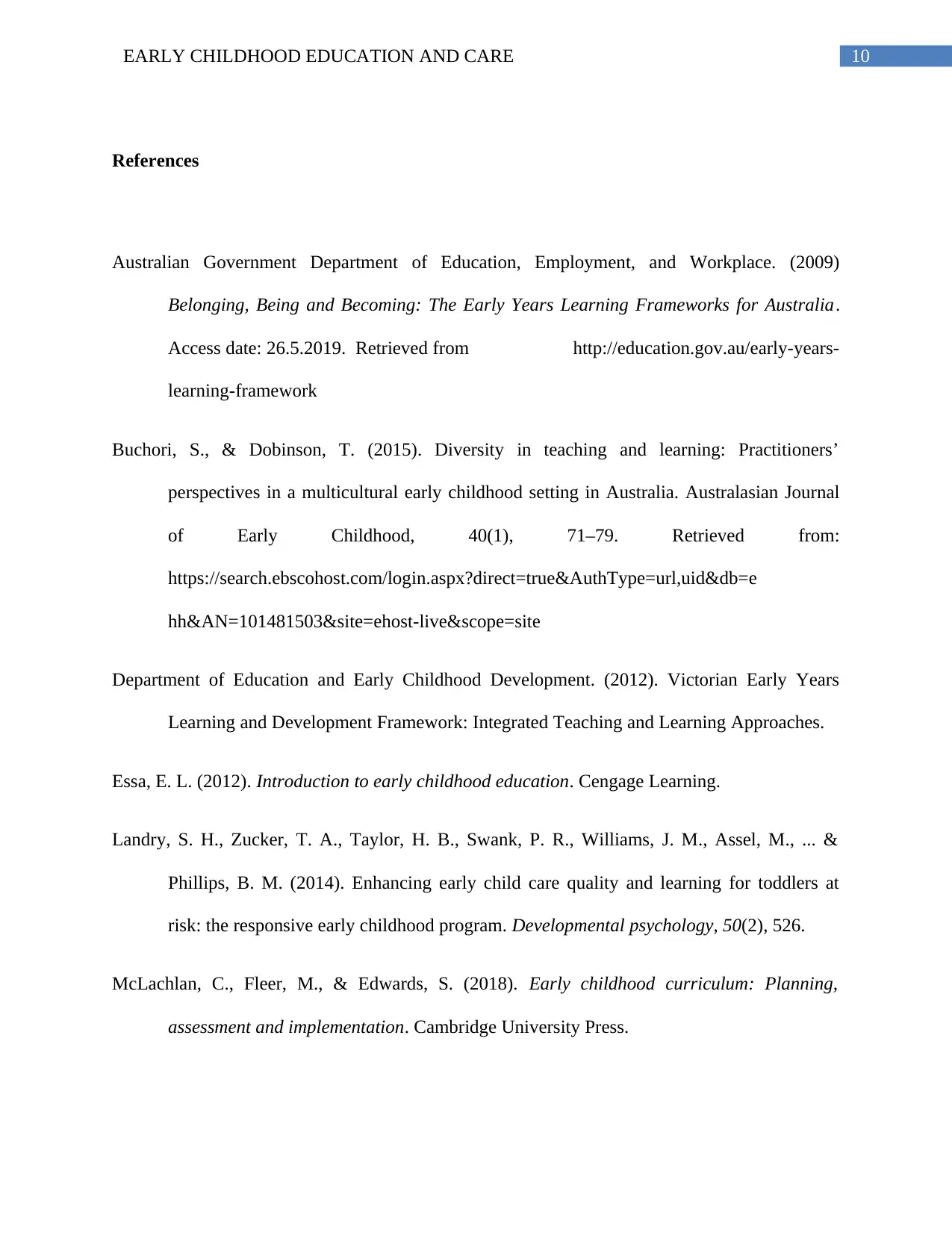
10EARLY CHILDHOOD EDUCATION AND CARE
References
Australian Government Department of Education, Employment, and Workplace. (2009)
Belonging, Being and Becoming: The Early Years Learning Frameworks for Australia.
Access date: 26.5.2019. Retrieved from http://education.gov.au/early-years-
learning-framework
Buchori, S., & Dobinson, T. (2015). Diversity in teaching and learning: Practitioners’
perspectives in a multicultural early childhood setting in Australia. Australasian Journal
of Early Childhood, 40(1), 71–79. Retrieved from:
https://search.ebscohost.com/login.aspx?direct=true&AuthType=url,uid&db=e
hh&AN=101481503&site=ehost-live&scope=site
Department of Education and Early Childhood Development. (2012). Victorian Early Years
Learning and Development Framework: Integrated Teaching and Learning Approaches.
Essa, E. L. (2012). Introduction to early childhood education. Cengage Learning.
Landry, S. H., Zucker, T. A., Taylor, H. B., Swank, P. R., Williams, J. M., Assel, M., ... &
Phillips, B. M. (2014). Enhancing early child care quality and learning for toddlers at
risk: the responsive early childhood program. Developmental psychology, 50(2), 526.
McLachlan, C., Fleer, M., & Edwards, S. (2018). Early childhood curriculum: Planning,
assessment and implementation. Cambridge University Press.
References
Australian Government Department of Education, Employment, and Workplace. (2009)
Belonging, Being and Becoming: The Early Years Learning Frameworks for Australia.
Access date: 26.5.2019. Retrieved from http://education.gov.au/early-years-
learning-framework
Buchori, S., & Dobinson, T. (2015). Diversity in teaching and learning: Practitioners’
perspectives in a multicultural early childhood setting in Australia. Australasian Journal
of Early Childhood, 40(1), 71–79. Retrieved from:
https://search.ebscohost.com/login.aspx?direct=true&AuthType=url,uid&db=e
hh&AN=101481503&site=ehost-live&scope=site
Department of Education and Early Childhood Development. (2012). Victorian Early Years
Learning and Development Framework: Integrated Teaching and Learning Approaches.
Essa, E. L. (2012). Introduction to early childhood education. Cengage Learning.
Landry, S. H., Zucker, T. A., Taylor, H. B., Swank, P. R., Williams, J. M., Assel, M., ... &
Phillips, B. M. (2014). Enhancing early child care quality and learning for toddlers at
risk: the responsive early childhood program. Developmental psychology, 50(2), 526.
McLachlan, C., Fleer, M., & Edwards, S. (2018). Early childhood curriculum: Planning,
assessment and implementation. Cambridge University Press.
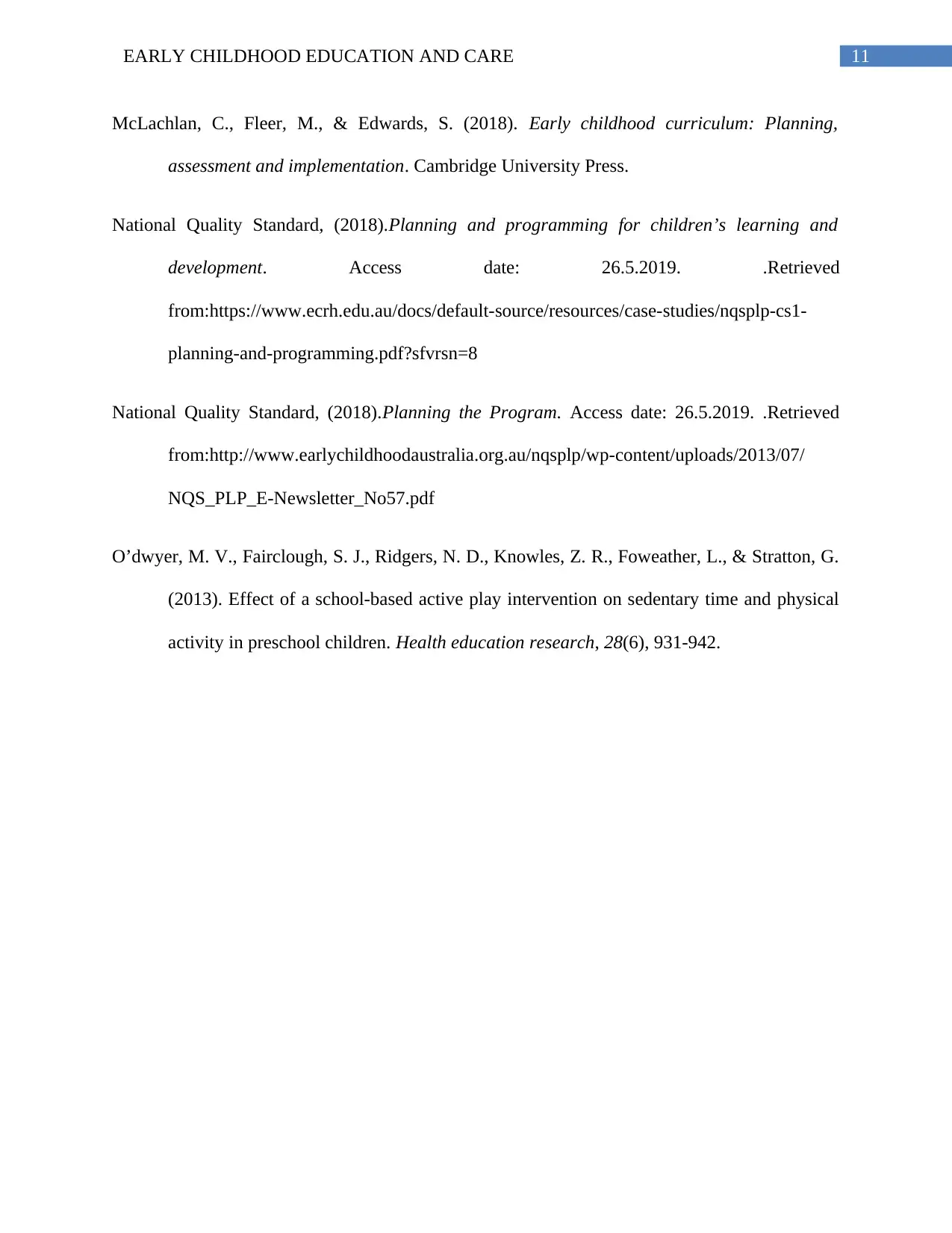
11EARLY CHILDHOOD EDUCATION AND CARE
McLachlan, C., Fleer, M., & Edwards, S. (2018). Early childhood curriculum: Planning,
assessment and implementation. Cambridge University Press.
National Quality Standard, (2018).Planning and programming for children’s learning and
development. Access date: 26.5.2019. .Retrieved
from:https://www.ecrh.edu.au/docs/default-source/resources/case-studies/nqsplp-cs1-
planning-and-programming.pdf?sfvrsn=8
National Quality Standard, (2018).Planning the Program. Access date: 26.5.2019. .Retrieved
from:http://www.earlychildhoodaustralia.org.au/nqsplp/wp-content/uploads/2013/07/
NQS_PLP_E-Newsletter_No57.pdf
O’dwyer, M. V., Fairclough, S. J., Ridgers, N. D., Knowles, Z. R., Foweather, L., & Stratton, G.
(2013). Effect of a school-based active play intervention on sedentary time and physical
activity in preschool children. Health education research, 28(6), 931-942.
McLachlan, C., Fleer, M., & Edwards, S. (2018). Early childhood curriculum: Planning,
assessment and implementation. Cambridge University Press.
National Quality Standard, (2018).Planning and programming for children’s learning and
development. Access date: 26.5.2019. .Retrieved
from:https://www.ecrh.edu.au/docs/default-source/resources/case-studies/nqsplp-cs1-
planning-and-programming.pdf?sfvrsn=8
National Quality Standard, (2018).Planning the Program. Access date: 26.5.2019. .Retrieved
from:http://www.earlychildhoodaustralia.org.au/nqsplp/wp-content/uploads/2013/07/
NQS_PLP_E-Newsletter_No57.pdf
O’dwyer, M. V., Fairclough, S. J., Ridgers, N. D., Knowles, Z. R., Foweather, L., & Stratton, G.
(2013). Effect of a school-based active play intervention on sedentary time and physical
activity in preschool children. Health education research, 28(6), 931-942.
⊘ This is a preview!⊘
Do you want full access?
Subscribe today to unlock all pages.

Trusted by 1+ million students worldwide
1 out of 12
Related Documents
Your All-in-One AI-Powered Toolkit for Academic Success.
+13062052269
info@desklib.com
Available 24*7 on WhatsApp / Email
![[object Object]](/_next/static/media/star-bottom.7253800d.svg)
Unlock your academic potential
Copyright © 2020–2025 A2Z Services. All Rights Reserved. Developed and managed by ZUCOL.





